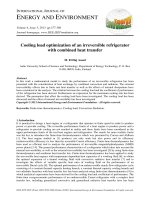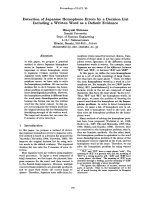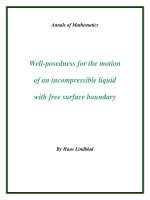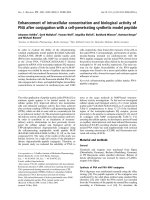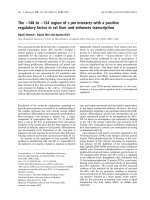- Trang chủ >>
- Khoa Học Tự Nhiên >>
- Vật lý
Detection of an uncharged steroid with a silicon nanowire field effect transistor
Bạn đang xem bản rút gọn của tài liệu. Xem và tải ngay bản đầy đủ của tài liệu tại đây (738.88 KB, 6 trang )
Sensors and Actuators B 138 (2009) 148–153
Contents lists available at ScienceDirect
Sensors and Actuators B: Chemical
journal homepage: www.elsevier.com/locate/snb
Detection of an uncharged steroid with a silicon nanowire field-effect transistor
Ko Shing Chang
a
, Chen Chia Chen
b
, Jeng Tzong Sheu
b,∗∗
, Yaw-Kuan Li
a,∗
a
Department of Applied Chemistry, National Chiao Tung University, 1001 Ta-Hseh Rd., Hsinchu 30010, Taiwan
b
Institute of Nanotechnology, National Chiao Tung University, 1001 Ta-Hseh Rd., Hsinchu 30010, Taiwan
article info
Article history:
Received 10 October 2008
Received in revised form 19 February 2009
Accepted 24 February 2009
Available online 13 March 2009
Keywords:
Biosensor
Silicon nanowire field-effect transistor
5
-3-Ketosteroid isomerase
Steroid
abstract
Among biosensors of various types, the silicon nanowire field-effect transistor (SiNW-FET) is believed to
be the most sensitive and powerful device for bio-applications. The principle of sensing is based on the
variation of conductivity resulting from a disturbance of charge on the surface of the SiNW-FET, but this
detection is feasible predominantly for charged analytes, such as a protein, DNA, antibody, virus etc. The
objective of our work was to overcome this intrinsic weakness of a SiNW-FET and to develop a platform
to detect steroids. For this purpose, we designed an engineered protein,
5
-3-ketosteroid isomerase, to
function asa steroid acceptor thatwas chemically modified witha carbonchain-linked 1,5-EDANS moiety,
and further immobilized on the surface of a silicon nanowire. In the presence of a steroid, the negatively
charged 1,5-EDANS moiety, which presumably occupies the steroid-binding site, is expelled and exposes
to the nanowire surface. The electrical response produced from the 1,5-EDANS moiety is measured and
the concentration is calculated accordingly. The sensitivity of this novel nano-bio-device can attain a
femtomolar level.
© 2009 Elsevier B.V. All rights reserved.
1. Introduction
Steroids are lipid compounds. With the exception of cholesterol,
steroids are natural hormones or hormone precursors. The deter-
mination of the levels of steroid hormones is an important issue
for the inspection of endocrinological disorders related to adrenal
or gonadal function. Among analytical methods used to determine
the concentrations of steroid hormones or their precursors are
immunoassays [1–3], fluorescence resonance energy transfer [4],
SPR [5], GC/MS [6–8] and LC/MS [9–11]. Our interest is a sensitive
assay for hormone detection that typically involves a mass spec-
trometer coupled with either a gas chromatograph (GC/MS) or a
liquid chromatograph (LC/MS). For these hormones, like anabolic
steroids, according to the differences in fragmentation caused by
collisions of medium energy related to the structure, it is difficult
to find a common product ion or neutral loss. Furthermore, not only
do most ELISA-like assays lack the sensitivity required to determine
>90% of hormone derivatives [12] but also these analytical proce-
dures might introduce artefacts. The detection limits of the above
methods range from ng/mL to pg/mL [13,14].
One-dimensional nanostructures such as carbon nanotubes
(CNT) and silicon nanowires (SiNW), have been demonstrated
∗
Corresponding author. Tel.: +886 3 5731985; fax: +886 3 5723764.
∗∗
Corresponding author. Tel.: +886 3 5712121x55805; fax: +886 3 5729912.
E-mail addresses: (J.T. Sheu),
(Y K. Li).
to be sensitive chemical and biological sensors [15]. That detec-
tion results from the disturbance of charge on the surface of
the functionalized nanostructure on which the target molecules
are specifically recognized. For instance, the real-time detection
of single viruses [16], various antigens [14,17], oligonucleotides
[18,19], proteins [20,21] and charged small molecules [22] has
been shown to be feasible on devices using nanowire or
carbon-nanotube transistors as active transducer. The sensing
mechanism in an electrically based biosensor relies on an altered
conductance or threshold voltage (V
th
) induced by the attach-
ment of the charged analytes. In this work, we attempted to
integrate protein engineering with the sensitive nature of a
SiNW-FET in charge disturbance to overcome the intrinsic weak-
ness of SiNW-FET in detecting uncharged analytes. We chose an
uncharged steroid, 19-norandrostendione (19-NA), as the target
analyte.
5
-3-Ketosteroid isomerase (KSI) has served as a receptor for
steroid recognition because of its well understood enzyme func-
tion [23–30]. The primary concept of the sensing mechanism is
based on intramolecular binding of a charged ligand, functioning as
a reporter, to mimic the binding of an analyte to a protein. The major
driving force favoring this association is generally thought to be the
hydrophobic effect that prompts the hydrophobic ligand to bind
with the protein. The thermodynamics of protein-ligand binding
can be altered by a favorable control of enthalpy and, particularly
in this model, the characteristic ‘entropy-driven’ thermodynamic
signature of the steroid. The analyte might replace the pre-situated
ligand, which b ecomes thus exposed to the surface of the SiNW and
0925-4005/$ – see front matter © 2009 Elsevier B.V. All rights reserved.
doi:10.1016/j.snb.2009.02.059
K.S. Chang et al. / Sensors and Actuators B 138 (2009) 148–153 149
Fig. 1. Design of a SiNW-FET for the detection of an uncharged analyte.
perturbs the charge density and conductance of the nanostructure.
Fig. 1 depicts the p-type SiNW-FET platform of this design.
2. Experiments
2.1. Design of an engineered protein, overexpression and
purification
The structural design of a KSI was based on the understanding
of a KSI from previous work undertaken by many groups [28,31].
To eliminate the possibility of multi-labeling and the complicated
orientation evolved from ligand conjugation and further protein
immobilization, we constructed a KSI mutant gene by PCR ampli-
fication with eight mutated sites (Y55F, K60R, F86C, F88G, K92R,
K108R, K119R, and A125K) in a single protein molecule. The result-
ing KSI mutant, designated Art
KSI, contains only one cysteine
residue (Cys-86) and one lysine residue at the C-terminus (Lys-125),
which serve for further chemical conjugation of the reporter and for
the immobilization of protein on SiNW, respectively.
The engineered protein, named Art
KSI, was constructed from
a pRSET A vector and further expressed in Escherichia coli BL21
(DE3) at 28
◦
C for 16h. A bacterial culture (1 L) was collected on
centrifugation and further resuspended in phosphate buffer (15 mL,
20 mM, pH 7.5). Cells were disrupted by ultra-sonication. A precip-
itant containing crude enzyme was obtained from the supernatant
on treating with ammonium sulfate (up to 50% saturation). The
crude enzyme was further resuspended in phosphate buffer (10 mL,
20 mM, pH 7.5). After desalting, the sample solution (10 mL) was
loaded onto a HiTrap Q column (30 mL, Pharmacia) for chromato-
graphic separation. The column was eluted with phosphate buffer
(20 mM, pH 7.5) at a flow rate 1 mL/min and a linear gradient
2.5 mM/min of NaCl. KSI was eluted in a range 50–75 mM of NaCl.
The protocol for protein purification is appropriate also for other
KSI mutants. The quality of the purified proteins was examined by
both SDS-PAGE and LC/MS.
2.2. Bioconjugation of Art
KSI with fluorophore (mA51)
The bioconjugate reaction was performed at 4
◦
C, for 12 h in
Tris–HCl buffer (50 mM, pH 7.5) containing enzyme (0.1 mM) and
labeling reagent (1 mM). The excess labeling reagent was removed
with dialysis or ultra-filtration. The efficiency of the labeling reac-
tion was evaluated with LC/MS. The modified protein is named
Art
KSI/mA51.
2.3. Fabrication of a SiNW device
This p-type SiNW-FET was fabricated on a 6 in. silicon-on-
insulator wafer which top silicon layer with boron-doped of
10
15
cm
−3
. The thicknesses of the top Si layer and the buried oxide
layer were 50 and 150 nm, respectively. The silicon nanowires
(SiNWs) were defined by electron-beam lithography and followed
by plasma etching. A SiO
2
film (thickness 10 nm) was thermally
grown as a screening oxide. The SiNWs were doped by boron
implantation with dose of 5 × 10
13
cm
−2
at 15 keV. After thermal
activation at 950
◦
C for 30 min, the screening oxide was removed
with HF solution. After defining the contact pad patterns, a stack
of Ti (10 nm) and Au (100 nm) was then evaporated with a ther-
mal evaporator and lifted off to create the contacts to the SiNW.
The p-type SiNW devices were sintered in nitrogen gas at 400
◦
C
for 10 min to ensure a good ohmic contact. The electric parame-
ter of SiNW-FET was measured using a semiconductor parameter
analyzer (HP 4155B) in the ambient.
2.4. Immobilization of the SiNW surface
Before immobilization of the Art
KSI/mA51 onto the SiNW,
these SiNW were pretreated with an UV/ozone plasma
(Samco model UV-1). The SiNW were further treated with 3-
aminopropyltriethoxysilane (APTES, Merck) on adding droplets
of APTES solution (2.2 mM) onto the top of the nanostructure
for 10 min. After reaction for 10 min, the chip was rinsed with
absolute ethanol three times and dried at 120
◦
C for 30 min. The
amine-derivatized nanowires were immersed in the Bis (sulfosuc-
cinimidyl) suberate (BS3, 5 mg/mL, Sigma, 20 min, 23
◦
C), and then
dried (37
◦
C, 15 min). Art KSI/mA51 (0.01 mM in 1 mM sodium
phosphate buffer, pH 7.0) coupled with the chemically activated
SiNW for 3 h at 23
◦
C. Tris (1 mM, pH 7.5) was then used to block
the remaining N-hydroxysulfosuccinimide groups [32].
3. Results and discussion
The Art
KSI was successfully expressed in E. coli and fur-
ther purified on an anion-exchange column. The quality of the
purified protein was confirmed with gel electrophoresis (sodium
dodecyl sulfate-polyacrylamide) to have homogeneity >95% (data
not shown). The precise molecular mass determined by LC/MS
analysis showed m/z = 13,402 Da (M+H
+
), consistent with the
molecular mass calculated from the amino-acid composition
of Art
KSI. Art KSI possesses substantial activity with a value
k
cat
/K
m
=1.12× 10
7
(M
−1
s
−1
) when
5
-androstene-3,17-dione is
used as substrate for assay. The result of enzymatic catalysis con-
firmed the protein folding of Art
KSI is maintained.
To convert the action of steroid binding into an electrical signal, a
negatively charged ligand (the reporter) must be covalently labeled
at the appropriate position of Art
KSI. The precursor of the reporter,
named mA51-mA51 (shown in Fig. 2), was synthesized on coupling
two molecules of 5-(2-aminoethylamino)-1-naphthalenesulfonic
acid (1,5-EDANS) with one 4,4
-dithiodibutyric acid. The Cys-86
residue, located at the rim of the steroid-binding site, was designed
to react with the mA51-mA51 through the thiol substitution to form
a new disulfide bond between the protein and the reporter (mA51).
The modified protein is designated Art
KSI/mA51; the success of
chemical conjugation of Art
KSI was confirmed on LC/MS analy-
sis as shown in Fig. 2. The Art
KSI/mA51 was further immobilized
on the SiNW through the Lys-125 residue (C-terminal residue) or
the amino group of the N-terminus. Based on an inspection of the
protein structure, we predict that either method immobilization
does not cause steric hindrance for steroid binding. In principle, the
reporter molecule can be expelled from the binding site and expose
to the surface of SiNW when a steroid is present. To ensure the fea-
sibility of this system, the binding affinity of the reporter should
be taken into account. If the reporter binds strongly to protein, it
is unlikely to be replaced by a steroid. In contrast, a weakly bind-
ing reporter cannot promise the application as most reporters are
outside the steroid-binding site. We chose 1,5-EDANS as the candi-
date reporter for its specific, but moderate, binding affinity towards
Art
KSI (K
d
= 0.35 mM). The mA51 moiety on the Art KSI/mA51 is
hence presumably able to fit into the steroid-binding site.
Immobilization of the protein was evaluated on examining the
observed density of gold nanoparticles (AuNPs) on a Si sample with
150 K.S. Chang et al. / Sensors and Actuators B 138 (2009) 148–153
Fig. 2. Mass-spectrometric analysis of modified KSI and the chemical structures of reporter and its precursor. (a) Mass spectrum of Art KSI conjugated with the reporter.
The measured molecular mass of Art
KSI/mA51 is 13,770 ± 2 Da, consistent with the calculated value 13,768 Da (13402 Da for Art
KSI and 366 Da for mA51 moiety). (b) The
structures of 1,5-EDANS, mA51 moiety and mA51-mA51.
a film of SiO
2
(thickness 30 nm) and surface modification at varied
stages, such as a treatment with APTES and also with BS3 and pro-
tein as shown in Fig. 3. Fig. 3 also presents SEM images of AuNP
on derivatized surfaces. As AuNPs were synthesize d through cit-
rate reduction [33], the negatively charged AuNPs are expected to
bind to the amine-derivatized surface effectively via an electrostatic
interaction [34]. After coupling with BS3, the amine-derivatized
SiO
2
surface was presumably converted into a sulfonated surface.
Fig. 3. Various stages of modification of a SiO
2
substrate and corresponding SEM images after treatment with AuNPs. The SEM images reveal the existence of AuNP on the
surface of the substrate with modification by (a) APTES, (b) BS3 and (c) KSI
126C.
K.S. Chang et al. / Sensors and Actuators B 138 (2009) 148–153 151
Fig. 4. Structure of the SiNW-FET device. (a) Scanning electron-microscope images of a SiNW (width 90 nm, height 40 nm) on silicon-on-insulator. (b) Diagram of the device
employed for sensing on adding 19-NA solution over the SiNW.
The deposition of AuNP hence became rare because of the repul-
sion force, as shown in Fig. 3.KSI
126C, a mutant with an extra
cysteine residue added at the C-terminus, was further immobi-
lized on this substrate through the reaction of lysine residue with
the BS3-activated surface. The resulting substrate was treated with
AuNP. If the immobilization of KSI
126C is effective, the deposition
of AuNP becomes much increased, presumably through the forma-
tion of an Au–S bond or an electrostatic interaction between the two
substances. The highly dense AuNP layout [Fig. 3(c)] clearly demon-
strates the ef ficiency of KSI immobilization under the conditions
employed in the case of SiNW.
The dimensions of SiNW were determined from measurements
with a scanning electron microscope [Fig. 4(a)] with a line width
about 80–100 nm. A measurement of the conductance of SiNW was
performed on adding the analyte between the source and drain
electrodes, as schematically demonstrated in Fig. 4(b); the dis-
tance between the two electrodes is approximately 50 m. The
typical output and transfer curve of SiNW-FETs were observed.
When the drain bias was set at 10 mV, the leakage current between
the source and drain electrodes was typically with the scale of
1 pA. The noise level of SiNW-FET sensors was around 0.1–1 nS,
and was often observed with the scale of 0.1 nS. The conductance
of the Art
KSI/mA51-labeled SiNW-FET becomes modulated when
the charge state of the surface is altered. As no existing reference is
available to justify the influence of a steroid in the present system,
we ensured that the observed signals were derived from the binding
of steroid to Art
KSI/mA51 by comparing the responses of SiNW-
FET modified by BS3 and further by Art
KSI. The effects of 19-NA on
those devices are shown in Fig. 5. The electrical response of SiNW-
FET was measured in Tris buffer (0.1 mM). Typical data for the time
dependence were obtained from the output of the Art
KSI/mA51-
labeled SiNW-FET after introducing 19-NA at varied concentrations.
The conductance of BS3- and Art
KSI-labeled SiNW-FET remained
constant on the addition of 19-NA up to 0.3 pM, indicating that the
background disturbance of 19-NA is insignificant [Fig. 5(a); data for
BS3-modified devices are not shown]. Upon addition of 19-NA at
various concentrations, the conductance of Art
KSI/mA51-labeled
SiNW-FET rapidly increased to a constant value [Fig. 5(b)]. 19-NA at
a greater concentration resulted in a greater conductance, indicat-
ing that 19-NA competed with mA51 for the steroid-binding site in
Art
KSI/mA51. The negatively charged mA51, of which the charge
can be compensated by a protein when it is bound, is expelled
to expose to the solution near SiNW. The correlation between the
increased conductance and the applie d 19-NA is shown in Fig. 6.A
satisfactorily linear correlation was found for 19-NA at a concentra-
tion greater than 0.6 fM. In summary, the variation of conductance
observed for Art
KSI/mA51-labeled SiNW-FET corresponds to the
specific binding of 19-NA to Art
KSI/mA51. The sensitivity of 19-
NA detection can attain a level of femtomolar. According to this
first successful demonstration, a SiNW-FET is usable for sensing
an uncharged analyte by integration with protein engineering. It is
Fig. 5. Response of conductance of a SiNW-FET in the presence of 19-NA with
Vds=10mV,Vgs=0V. Arrowsindicate the point of addition of 19-NA to SiNW-FET
labeled with (a) Art
KSI and (b) Art KSI/mA51 at concentrations (1) 1.3 fM, (2) 13 fM,
(3) 130 fM, and (4) 1300 fM. Note that the measurement of the conductance change
was performed by adding 10 L of Tris buffer (0.1 mM, pH 7.5), as a background
conductance, between the source and drain electrodes of SiNW [as schematically
demonstrated in Fig. 4(b)] and further directly and subsequently added 5 Lofthe
various concentration of 19-NA stock solution on top of the existed sample solution.
152 K.S. Chang et al. / Sensors and Actuators B 138 (2009) 148–153
Fig. 6. Linear correlation of the variation of conductance for an Art KSI/mA51-
labeled SiNW-FET with respect to the applied concentration of 19-NA. The abscissa
shows the 19-NA concentration on a logarithmic scale in mol unit. Each data point
is the average of 130 times of measurements. G
0
= conductance at 0.13 fM 19-NA,
G = conductance at varied concentration of 19-NA, G = G − G
0
.
worth to note that the conductance of SiNW showed a signal spike
at the point when analyte (19-NA) was added. This phenomenon
was commonly observed in literatures with similar studies [35–37].
Although the mechanism of the appearance of signal spike is not
clear, it is assumed that the spike is resulted from the disturbance
or the redistribution of the double layer when analyte was added.
4. Conclusion
A silicon-based nanobiosensor, SiNW-FET, for the detection of
steroid was fabricated. An engineered steroid-binding protein,
5
-
3-ketosteroid isomerase, was chemically modified with a charged
reportermolecule containing 1,5-EDANS moiety,and further immo-
bilized on the surface of a silicon nanowire. In the presence of
a steroid, the negatively charged 1,5-EDANS moiety is expelled
and exposes to the nanowire surface and consequently produces
electrical response. According to the change of conductivity, the
concentration of 19-NA is calculated. The sensitivity of this novel
nano-bio-device can attain a femtomolar level.
Acknowledgements
National Science Council and the MOE-ATU Program in Taiwan
provided financial support.
References
[1] B.G. England, G.H. Parsons, R.M. Possley, D.S. McConnell, A.R. Midgley, Ultra-
sensitive semiautomated chemiluminescent immunoassay for estradiol, Clin.
Chem. 48 (2002) 1584–1586.
[2] J. Taieb, C. Benattar, A.S. Birr, A. Lindenbaum, Limitations of steroid determina-
tion by direct immunoassay, Clin. Chem. 48 (20 02) 583–585.
[3] N.L. Hungerford, B. Sortais, A.G. Smart, A.R. McKinney, D.D. Ridley, A.M. Sten-
house, C.J. Suann, K.J. Munn, M.N. Sillence, M.D. McLeod, Analysis of anabolic
steroids in the horse: development of a generic ELISA for the screening of
17␣-alkyl anabolic steroid metabolites, J. Steroid Biochem. Mol. Biol. 96 (2005)
317–334.
[4] S. De, I.G. Macara, D.A. Lannigan, Novel biosensors for the detection of estrogen
receptor ligands, J. Steroid Biochem. Mol. Biol. 96 (2005) 235–244.
[5] K.T. Toshie, F. Tomofumi,O. Tadashi, S. Takayoshi, N.M. Tomoko, S. Yoji, J.I. Swada,
K.A. Inoue, S. Koichi, O. Yasuo, Y. Teruhide, HX531, a retinoid X receptor antag-
onist, inhibited the 9-cis retinoic acid-induced binding with steroid receptor
coactivator-1 as detected by surface plasmom resonance, J. Steroid Biochem.
Mol. Biol. 94 (2005) 303–309.
[6] R. Ventura, M. Roig, B. Perez, S. Lopex, M. Medina, J. Bosch, J. Segura, Detection
of the administration of 17-nortestosterone in boars by gas chromatogra-
phy/mass spectrometry, Rapid Commun. Mass Spectrom. 22 (2008) 1863–1870.
[7] S. Torrado, J. Segura, M. Farre, R. Ventura, Gas chromatography–mass spectrom-
etry method for the analysis of 19-nor-4-androstenediol and metabolites in
human plasma: Application to pharmacokinetic studies after oral administra-
tion of a prohormone supplement, Steroids 73 (2008) 751–759.
[8] N. Shama, S.W. Bai, B.C. Chung, B.H. Jung, Quantitative determination of pro-
gesterones and corticosteroids in human urine using gas chromatography/mass
spectrometry: application to pelvic organ prolapsed patients, Rapid Commun.
Mass Spectrom. 22 (2008) 959–964.
[9] F. Qin, Y Y. Zhao, M.B. Sawyer, X F. Li, Hydrophilic interaction liquid
chromatography-tandem mass spectrometry determination of estrogen con-
jugations in human urine, Anal. Chem. 80 (2008) 340 4–3411.
[10] O.J. Pozo, P.V. Eenoo, W.V. Thuyne, K. Deventer, F.T. Delbeke, Direct quan-
tification of steroid glucuronides in human urine by liquid chromatography-
electrospray tandem mass spectrometry, J. Chromatogr. A 1183 (2008) 108–
118 .
[11] Y.C. Ma, H.Y. Kim, Determination of steroids by liquid chromatography/mass
spectrometry, J. Am. Soc. Mass Spectrom. 8 (1997) 1010–1020.
[12] J. Geisler, D. Ekse, H. Helle, N.K. Duong, P.E. Lonning, An optimized, highly sensi-
tive radioimmunoassay for the simultaneous measurement if estrone estradiol
and estrone sulfate in the ultra-low range in human plasma samples, J. Steroid
Biochem. Mol. Biol. 109 (2008) 90–95.
[13] E.A.S. Aldujaili, Development and validationof a simple and direct ELISA method
for the determination of conjugated (glucuronide) and non-conjugated testos-
terone excretion in urine, Clin. Chim. Acta 364 (2006) 172–179.
[14] X. Yuan, B.M. Forman, Detection of designer steroids, Nucl. Recept. Signal. 3
(2005) e002.
[15] Y. Cui, Q. Wei, H. Park, C.M. Lieber, Nanowire nanosensors for highly sensitive
and selective detection of biological and chemical species, Science 293 (2001)
1289–1292.
[16] F. Patolsky, G. Zheng, O. Hayden, M. Lakadamyali, X. Zhuang, C.M. Lieber,
Electrical detection of single viruses, Proc. Natl. Acad. Sci. U.S.A. 101 (200 4)
14017–14022.
[17] S.Pal, E.C. Alocilja, P.F. Downes, Nanowire labeled direct-charge transfer biosen-
sor for detecting Bacillus species, Biosens. Bioelectron. 22 (2007) 2329–2336.
[18] H.M. So, K. Won, Y.H. Kim, B.K. Kim, B.H. Ryu, P.S. Na, H. Kim, J.O. Lee, Single-
walled carbon nanotube biosensors using aptamers as molecular recognition
elements, J. Am. Chem. Soc. 127 (2005) 11906–11907.
[19] D.S. Kim, Y.T. Jeong, H.J. Park, J.K. Shin, P. Choi, J.H. Lee, G. Lim, An FET-type charge
sensor for highly sensitive detection of DNA sequence, Biosens. Bioelectron. 20
(2004) 69–74.
[20] K. Besteman, J.O. Lee, F.G.M. Wiertz, H.A. Heering, C. Dekker, Enzyme-coated
carbon nanotubes as single-molecule biosensors, Nano Lett. 3 (2003) 727–730.
[21] F. Patolsky, C.M. Lieber, Nanowire nanosensors, Mater. Today 8 (2005) 20–28.
[22] W.U. Wang, C. Chen, K.H. Lin, Y. Fang, C.M. Lieber, Label-free detection of small-
molecule-protein interactions by using nanowire nanosensors, Proc. Natl. Acad.
Sci. U.S.A. 102 (2005) 3208–3212.
[23] F.S. Klawahara, S.F. Wang, P. Talalay, The preparation and properties of crys-
talline
5
-3-ketosteroid isomerase, J. Biol. Chem. 237 (1962) 1500–1506.
[24] A. Kuliopulos, D. Shortle, P. Talalay, Isolation and sequencing of the gene encod-
ing
5
-3-ketosteroid isomerase of Pseudomonas testosterone: overexpression
of the protein, Proc. Natl. Acad. Sci. U.S.A. 84 (19 87) 8893–8897.
[25] L. Xue, A. Kuliopulos, A.S. Mildvan, P. Talalay, Catalytic mechanism of an
active-site mutant (D38N) of
5
-3-ketosteroid isomerase. Direct spectroscopic
evidence for dienol intermediates, Biochemistry 30 (1991) 4991–4997.
[26] R.M. Pollack, Enzymatic mechanisms for catalysis of enolization: ketosteroid
isomerase, Bioorg Chem. 32 (2004) 341–353.
[27] K. Sharma, R. Vazquez-Ramirez, C. Kubli-Garfias, A theoretical model of the
catalytic mechanism of the
5
-3-ketosteroid isomerase reaction, Steroids 71
(2006) 549–557.
[28] H.S. Cho, G. Choi, K.Y. Choi, B.H. Oh, Crystal structure and enzyme mechanism
5
-3-ketosteroid isomerase from Pseudomonas testosterone, Biochemistry 37
(1998) 8325–8330.
[29] Y K. Li, A. Kuliopulos, A.S. Mildvan, P. Talalay, Environments and mechanistic
roles of the tyrosine residues of
5
-3-ketosteroid isomerase, Biochemistry 32
(1993) 1816–1824.
[30] P. Wu, Y K. Li, P. Talalay, L. Brand, Characterization of the three tyrosine
residues of
5
-3-ketosteroid isomerase by time-resolved fluorescence and cir-
cular dichroism, Biochemistry 33 (1994) 7415–7422.
[31] S.W. Kim, S S. Cha, H S. Cho, J S. Kim, N C. HA, M J. Cho, S. Joo, K.K. Kim, K.Y.
Choi, B H. Oh, High-resolution crystal structure of
5
-3-ketosteroid isomerase
with and without a reaction intermediate analogue, Biochemistry 36 (1997)
14030–14036.
[32] K.E. Tripodi, W.L. Turner, S. Gennidakis, W.C. Plaxton, In vivo regulatory phos-
phorylation of novel phosphoenolpyruvate carboxylase isoforms in endosperm
of developing castor oil seeds, Plant Physiol. 139 (2005) 969–978.
[33] G.Frens, Controlled nucleation of the regulation of the particle size in monodis-
perse gold solution, Nat. Phys. Sci. 241 (1973) 20–22.
[34] J.T. Sheu, C.C. Chen, P.C. Huang, Selective deposition of gold nanoparticles
on SiO
2
/Si nanowires for molecule detection, Jpn. J. Appl. Phys. 44 (2005)
2864–2867.
[35] A.D. Aguilar, E.S. Forzani, X. Li, N. Tao, L.A. Nagahara, I. Amlani, R. Tsui, Chemical
sensors using peptide-functionalized conducting polymer nanojunction arrays,
Appl. Phys. Lett. 87 (2005) 193108–193110.
[36] Y. Chen, X. Wang, S. Erramilli, P. Mohanty, A. Kalinowski, Silicon-based nano-
electronic field-effect pH sensor with local gate control, Appl. Phys. Lett. 89
(2006) 223512–223514.
K.S. Chang et al. / Sensors and Actuators B 138 (2009) 148–153 153
[37] G.B. Kan, J.M. Park, S.G. Kim, J.G. Koo, J.H. Park, Y.S. Sohn, Y.T. Kim, Fabrication
and characterisation of CMOS compatible silicon nanowire biosensor, Electron.
Lett. 44 (2008) 953–955.
Biographies
Ko-Shing Chang was born in Taiwan. He received the BS degree in Department of
Chemistry at Tunghai University, Taiwan, in 2000. He further received his MS degree
in the Department of Applied Chemistry, National Chia-Tung University, Taiwan, in
2002. He is currently working for his PhD degree at the Department of Applied
Chemistry of Nation Chiao Tung University, Taiwan. His research interests include
nanosensor and biochemistry.
Chen-Chia Chen was born in Taiwan. He received the BS and MS degrees in elec-
tronics from the National Yunlin University of Science and Technology, Taiwan, in
1995 and 1998, respectively. He received the PhD degree in electrical engineering at
National Chi Nan University, Taiwan. He has been the postdoctoral fellow at National
Chiao Tung University, Taiwan since 2007. His research interests include nanosensor,
nanoelectronic fabrication and organic electronics.
Jeng-Tzong Sheu was born in Taiwan in 1961. He received the BS and MS degrees in
electronical engineering from National Central University, Hsinchu, Taiwan, in 1984
and 1986, respectively. From 1986 to 1988, he served as a Navy officer at Kaohsiung,
Taiwan. Then he earned the PhD degree in Department of Electrical Engineering from
Michigan State University, East Lansing, USA, in 1994. From 1994 to 1996, he joined
National Nanodevices Laboratory, Hsinchu, Taiwan. Then, he worked as an asso-
ciated researcher at National Synchrotron Research Center, Hsinchu, Taiwan from
1996 to 2002. In August 2002, he joined the faculty of Department of Electrical Engi-
neering, National Chi-Nan University, Puli, Taiwan. He moved back to Hsinchu and
served as a faculty member in the Institute of Nanotechnology, National Chiao Tung
University, Hsinchu, Taiwan in August, 2004. His research interests include bridging
the bottom-up and the top-down nanofabrication techniques for nanoelectronics
and nanobiosensors. Moreover, system integration for probing the living cells with
nanodevices is also emphasized.
Yaw-Kuen Li received the BS degree from the National Tsing Hua University, Hsinchu,
Taiwan, in 1981, the MS degree from the National Cheng Kung University, Tainan, Tai-
wan, in 1987, and the PhD degree from Tulane University, New Orleans, LA, USA, in
1991, in chemistry. From 1991 to 1993, he was a Postdoctoral Fellow in the School of
Medicine, Johns Hopkins University, Baltimore, MD, USA. He then joined the Depart-
ment of Applied Chemistry, National Chiao Tung University, Taiwan, as a full-time
faculty member, in 1993. His research interests include carbohydrates chemistry,
enzyme chemistry, protein engineering and other multidisciplinary research such
as biosensing and nanobiotechnology.
